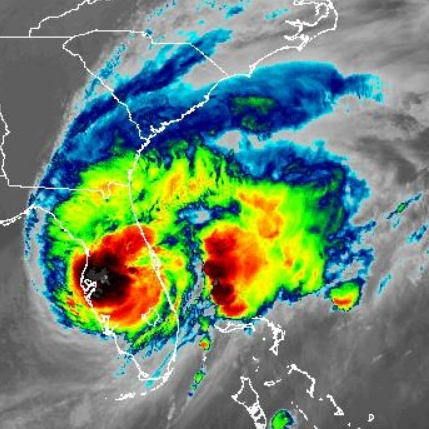
An infrared image of Hurricane Milton just after landfall in Florida on October 9, 2024. Courtesy, NOAA
Record-breaking storm brought 38 tornadoes and flooding along Florida’s West Coast
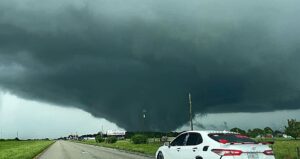
The Clewiston, Florida tornado spawned by Hurricane Milton the morning before landfall on October 10, 2024. Courtesy, Greg Tavers
In the midst of an already devastating hurricane season, Hurricane Milton first popped onto radars on October 4th as a swirl in the Gulf of Mexico under the name Tropical Depression Fourteen, before exploding into a category 5 hurricane almost overnight. Over a 15-hour span between October 6th and 7th, Milton’s windspeeds doubled from 90 mph to 180 mph, setting off alarms across Florida and a series of worsening predictions for the damage the storm would bring.
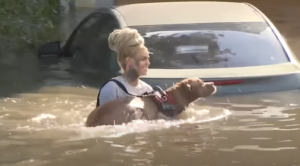
A woman and her dog wade through the floodwater in Clearwater the morning after Hurricane Milton made landfall.
Tampa and the surrounding bay area were on high alert for storm surge of 10-15 feet, with mass evacuations ordered by law enforcement and local governments to try to stop the brunt of the destruction. Meteorologists warned repeatedly of the imminent danger as Milton shattered many storm records, bringing the most tornado warnings in Florida history, massive amounts of rainfall, widespread flooding, and the lowest barometric pressure observed in an Atlantic hurricane since Wilma in 2005.

One of many flooded neighborhoods along the Little Wekiva River in Altamonte Springs, near Florida’s East Coast, from Milton’s soaking rains.
While the models predicted one of the largest and most dangerous storms in modern history, by the time Milton made landfall near Siesta Key late on the evening of October 9th (some 67 miles south of its original – and more deadly – path towards Tampa) it had lessened to a Category 3 and thankfully moved rather swiftly through Central Florida, well south of Orlando. Still, even with this slight relief, Milton and its 120 mph winds caused widespread damage and flooding across the Sunshine State, and many of the same areas that had just worked through the nightmare and rebuilding of Hurricanes Ian and Nicole only two years ago – and in the greater Tampa Bay area just two weeks ago from Hurricane Helene – were thrust back into the dark.

The damage from one of the many deadly tornados that struck St. Lucie County, Florida on the afternoon of October 10, 2024 prior to Hurricane Milton’s landfall
The record-breaking 126 tornado warnings from Milton spawned nearly 40 tornadoes throughout Florida, which caused the first losses of life from the storm in St. Lucie County prior to Milton making landfall. Pictures of the tornados’ aftermath in the Spanish Lakes Country Club Village – overturned cars and decimated houses – showed that damage from the weakened Milton would still be incredibly significant. “I tried to get prepared for the hurricane and then the tornado hit … this is a double disaster,” said St. Lucie County resident Calvin Lee Hamilton in an interview with The Weather Channel. As Hamilton and many others hunkered down in their bathrooms, a deafening roar began to fill the air. Only luck and a few hundred feet separated them from their neighbors and the direct path of the twisters – which reduced many of the houses to rubble and claimed 6 lives. Our thoughts and prayers go out to those who had their lives and livelihoods uprooted by the terrible storm.
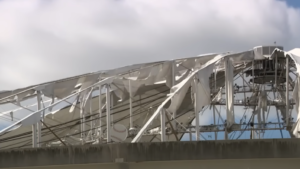
St. Petersburg’s Tropicana Field had its fiberglass roof shredded by Milton’s winds
Nearly 4 million Floridians were left without power after Milton hit, and the Tampa Bay area saw enough rain to have the storm qualified as a 1-in-1000-year rainfall event. St. Petersburg alone had 18.31 inches dumped on them in a 24-hour period along with hurricane force winds, leading to inundated streets and a haunting image of Tropicana Field, whose fiberglass roof was ripped to shreds by the gusts. After the Tampa mayor warned that several construction project cranes might fall thanks to Milton, the office building that houses the Tampa Bay Times headquarters was indeed partially crushed by a falling crane.
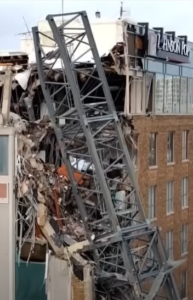
The St. Petersburg downtown crane collapse. Courtesy, City of St. Petersburg
Pictures from the building’s wreckage have also been widely circulated to truly show the devastation in the wake of the storm. Storm surge also wreaked havoc in many Florida cities and counties, with the worst in Sarasota County where 8-10 feet of water punctuated the terrible storm. Flood warnings across Florida ranging from major to minor floods are still in effect around rivers that are expected to last for days to weeks, according to the NWS. The latest catastrophe claims data shows the total estimated insured loss to be $586 million so far from nearly 44,000 claims filed as of this past Friday (October 11). Major analytics firms agree that total insured losses from Milton will be in the $30 billion to $50 billion range.
Many evacuees returning home this weekend found a wasteland, with widespread debris, flooded streets, power outages, and a shortage on gasoline at a staggering 77% of the greater Tampa-St. Petersburg area. The state has since opened three fuel distribution sites, where motorists can get $10 of gas for free. More stations should be open in the coming days as other teams help restore power to the 470,000 remaining households still without it late Sunday (October 13) night.
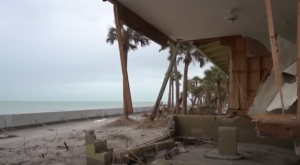
Milton’s 120 mph winds and 8-10 foot storm surge gutted this Gulf-front home in Manasota Key
Tragically, for some 23 Floridians this storm was their last, and for hundreds of thousands of others there is now a rocky road to recovery. First with Ian in 2022, more recently with Helene, and now Milton. While the names continue to change, the destruction and upheaval and cost of human life do not. Across Florida and the southeastern US, time and time again people must find the strength to pick up the pieces and rebuild themselves and their wider communities.
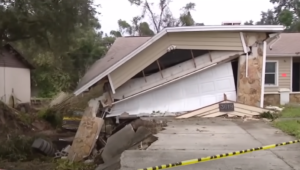
Ground collapse of a home in the Kathleen community of Polk County from Milton’s heavy rains
Our hearts go out to all those affected by the storm. We are inspired by your bravery and resilience in the face of such tragedies. With tens of thousands of feet on the ground working to restore our towns and cities who’ve already rescued 1,000 people, we can only hope for the best and say thank you to the first responders who are working tirelessly to bring back a sense of normalcy.
If you’d like to help the victims of Milton, please consider donating to the Florida Disaster Fund. It’s part of the Volunteer Florida Foundation, Florida’s official 501(c)(3) charitable organization and donations are tax deductible. You can also text “disaster” to 20222. Remember, if you ever need a helping hand, we’re only a call or click away here at LMA.
LMA Newsletter of 10-14-24

